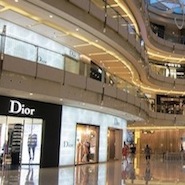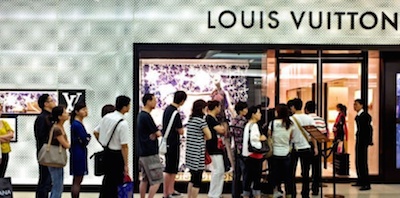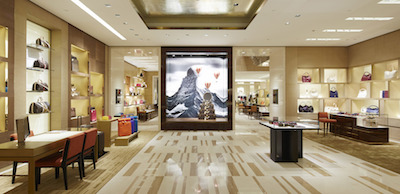 Dior store in Chinese shopping mall
Dior store in Chinese shopping mall
Chinese tourists spent $229 billion in 2015, according to a new report from GfK, Germany’s largest market research institute.
Although some of this money is spent in Hong Kong or in Southeast Asian countries where luxury brands do not yet have a large presence, such as Thailand and Taiwan, tourism to Europe, North America, South Korea and Japan is also way up. Beyond illustrating once again the importance of reaching Chinese travelers, the data reveals trends in movement and spending that can help luxury brands reach the group.
"China's outbound tourists remain strategic toHong Kong and its businesses - but other destinations are jumping ahead in winning their favor," said Laurens van den Oever, global head of travel and hospitality research at GfK. "Destinations such as Hong Kong need to re-evaluate China's new breed of young and independently-minded travelers, to understand how best to attract them and capitalize on the growth of China's outbound tourism."
Globetrotters
Although the $229 billion number includes all tourists, not just affluent ones, both the opportunity to buy goods for less in other countries and the occasion of travel may lead a consumer to treat herself to a luxury item or to purchase entry level items. In particular, the data shows that Chinese millennials in particular are more willing to splurge or pamper themselves with an expensive purchase.
 Chinese consumers line up outside a Louis Vuitton boutique
Chinese millennials are the biggest spenders on luxury goods in the APAC region. The group also tends to cherish freedom to travel more than parents or grandparents and are technologically savvy and heavy social media users, making them an ideal target for brands.
Although the luxury industry by now understands that it needs to appeal to Chinese travelers, understanding the age distribution can help brands prepare. Half of China’s outbound travelers are between the ages of 15 and 29, compared to 37 percent aged 30-44.
Additionally, the research notes that 66 percent of Chinese millennials belong to the high-income bracket, with earnings expected to increase in the coming years. The volume and wealth of the Chinese millennial group therefore makes it a particularly lucrative group of potential consumers.
Where these tourists are going is also undergoing changes. Since 2011, visits to South Korea are up 112 percent, visits to Japan are up 157 percent, visits to North America are up 151 percent and Europe, the most visited destination outside Asia, has seen 97 percent more tourist traffic from China.
Chinese consumers line up outside a Louis Vuitton boutique
Chinese millennials are the biggest spenders on luxury goods in the APAC region. The group also tends to cherish freedom to travel more than parents or grandparents and are technologically savvy and heavy social media users, making them an ideal target for brands.
Although the luxury industry by now understands that it needs to appeal to Chinese travelers, understanding the age distribution can help brands prepare. Half of China’s outbound travelers are between the ages of 15 and 29, compared to 37 percent aged 30-44.
Additionally, the research notes that 66 percent of Chinese millennials belong to the high-income bracket, with earnings expected to increase in the coming years. The volume and wealth of the Chinese millennial group therefore makes it a particularly lucrative group of potential consumers.
Where these tourists are going is also undergoing changes. Since 2011, visits to South Korea are up 112 percent, visits to Japan are up 157 percent, visits to North America are up 151 percent and Europe, the most visited destination outside Asia, has seen 97 percent more tourist traffic from China.
 DVF store in Beijing
However, as with any group of people, the Chinese often plan travel based on exchange rates. As the dollar has strengthened over the past several months, some travelers who may have recently traveled to or contemplated travel to North America may opt for Europe.
Given the enormous role of Chinese tourists in the luxury industry, brands need to be attuned to these patterns of movement and demographic profiles in order to more effectively plan for and build relationships with travelers. A shopping trip abroad gives a brand one chance to make a great, memorable impression, and doing so could create a fan that seeks out the name wherever she goes.
New markets
Sometimes travelers are the difference between strong quarterly earnings and lackluster ones.
For example, high sales in Western Europe and Japan led to decent third quarter results for Kering, suggesting strong business from Chinese tourists.
The Kering Group saw luxury sales increase by 14 percent on a reported basis and slightly more than 3 percent on a comparable basis in the third quarter of 2015 compared to the year-ago. Much of this improvement can be attributed to a variety of economic factors taking Chinese consumers to Western Europe and Japan, where Kering’s presence is relatively strong (see story).
Although North America, Europe, and nearby APAC countries are the oft-cited destinations of Chinese travelers, Africa and the Middle East are both attracting a fair share of the group. Travel to the Middle East has nearly tripled since 2011, and while Africa remains the least-visited continent, travel has more than quadrupled in the same timeframe.
DVF store in Beijing
However, as with any group of people, the Chinese often plan travel based on exchange rates. As the dollar has strengthened over the past several months, some travelers who may have recently traveled to or contemplated travel to North America may opt for Europe.
Given the enormous role of Chinese tourists in the luxury industry, brands need to be attuned to these patterns of movement and demographic profiles in order to more effectively plan for and build relationships with travelers. A shopping trip abroad gives a brand one chance to make a great, memorable impression, and doing so could create a fan that seeks out the name wherever she goes.
New markets
Sometimes travelers are the difference between strong quarterly earnings and lackluster ones.
For example, high sales in Western Europe and Japan led to decent third quarter results for Kering, suggesting strong business from Chinese tourists.
The Kering Group saw luxury sales increase by 14 percent on a reported basis and slightly more than 3 percent on a comparable basis in the third quarter of 2015 compared to the year-ago. Much of this improvement can be attributed to a variety of economic factors taking Chinese consumers to Western Europe and Japan, where Kering’s presence is relatively strong (see story).
Although North America, Europe, and nearby APAC countries are the oft-cited destinations of Chinese travelers, Africa and the Middle East are both attracting a fair share of the group. Travel to the Middle East has nearly tripled since 2011, and while Africa remains the least-visited continent, travel has more than quadrupled in the same timeframe.
 Louis Vuitton store in Shenyang, China
As these regions experience a growth in travel, it should also be noted that there are signs they may soon emerge as luxury hubs.
Africa’s Lagos, Nigeria and South Asia’s Mumbai, India are poised to become major players in the luxury world, according to a November 2015 report by commercial real estate services adviser CBRE.
Although nobody should expect another China, the residents of the Nigerian and Indian cities are already beginning to make their presence known to luxury brands. Continuing globalization ensures that the economy will remain a major factor in the luxury market, so brands must be attuned to economic patterns and shifts to stay ahead (see story).
As for the Middle East, as tourism increases, some brands are also making their entrance.
In October, British accessories label Anya Hindmarch entered a franchise agreement with Etoile Group to establish a retail footprint in the Middle East.
Anya Hindmarch’s terms with Etoile Group will see the establishment of stores and concessions in the Middle East, beginning in Abu Dhabi, United Arab Emirates. When entering into an unfamiliar market, it is helpful and important for brands to partner with a local entity that has an understanding of the culture and consumer sentiment (see story).
Louis Vuitton store in Shenyang, China
As these regions experience a growth in travel, it should also be noted that there are signs they may soon emerge as luxury hubs.
Africa’s Lagos, Nigeria and South Asia’s Mumbai, India are poised to become major players in the luxury world, according to a November 2015 report by commercial real estate services adviser CBRE.
Although nobody should expect another China, the residents of the Nigerian and Indian cities are already beginning to make their presence known to luxury brands. Continuing globalization ensures that the economy will remain a major factor in the luxury market, so brands must be attuned to economic patterns and shifts to stay ahead (see story).
As for the Middle East, as tourism increases, some brands are also making their entrance.
In October, British accessories label Anya Hindmarch entered a franchise agreement with Etoile Group to establish a retail footprint in the Middle East.
Anya Hindmarch’s terms with Etoile Group will see the establishment of stores and concessions in the Middle East, beginning in Abu Dhabi, United Arab Emirates. When entering into an unfamiliar market, it is helpful and important for brands to partner with a local entity that has an understanding of the culture and consumer sentiment (see story).
